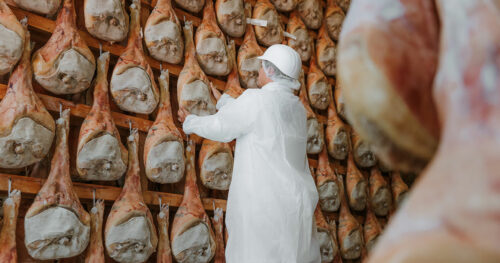Although it holds an ancient history, it currently is one of the world’s favorite Made in Italy food products: Prosciutto di San Daniele is the expression of a territory, Friuli-Venezia Giulia, but mostly of the craftmanship handed down from generation to generation by master prosciutto makers.
With great care, passion and dedication, the “masters” of the prosciutto production are committed to turning an excellent raw material into the iconic Prosciutto di San Daniele.
But let’s step back and talk about raw materials. Do you know how a San Daniele DOP is made? In this article we’d like to take you on a one of a kind culinary journey.
The secret of Prosciutto di San Daniele? Only three ingredients!
It is no coincidence if we say that “the secret of San Daniele is…San Daniele!”. The peculiar microclimate of the area of San Daniele del Friuli plays a key role in the aging of the product and in making it so tasty and flavourful.
From the geographical point of view, in the area of the Friulian village the breeze of the Adriatic Sea, the winds that come from the Carnic Pre – Alps and the Tagliamento river merge.
The Tagliamento has a specific task, it is a natural temperature controller. This encounter of natural elements creates a one of a kind environmental condition which is able to generate a constant and light ventilation.
Pork hind legs: selection and high quality
To make a perfect San Daniele DOP you don’t need many ingredients. Its strenght lies in the “simpleness” of only three ingredients which, perfectly selected and combined, allow us to create a food perfect both for its taste and its nutritional values.
Let’s first of all talk about the quintessential raw material, that is the pork hind leg. If you fondly follow our magazine, you already know that not all hind legs are alike.The ones selected to make Prosciutto di San Daniele are made and processed only in our Peninsula: the pork hind lesgs come from 3.626 selected breeding farms in only 10 Italian regions.
The areas where the raw material comes from are in the north and center of Italy and they are: Friuli-Venezia Giulia, Veneto, Lombardy, Piedmont, Emilia Romagna, Tuscany, Latium, Abruzzo, Marche and Umbria.
The selection of the hind legs is essential and it follows very strict criteria : to make San Daniele DOP only pigs of the Large White, Landrace and Italian Duroc breeds are chosen. Compliant breeds are also mixed-race and hybrid pigs, but only if they come from selection schemes or cross-breedings compatible with those in the Italian Herd Book.
An animal DNA databank has been created to closely monitor the origin of the pigs, this device allows us to avoid genetical fraud and counterfeiting.
It’s not just a matter of breed: the pigs selected to make Prosciutto di San Daniele DOP must match specific weight and size requirements. In particular they must comply with a weight of 160 kilograms on average, while every hind leg must have a weight between 12,5 kg and 17,5 kg, with a constant ratio between lean and fat mass.
Did you know that also the fat part musy comply with very specific criteria? The fat layer shall have a texture and thickness of no less than 15 millimeters including the rind.
Sea salt, an essential element in the processing of San Daniele DOP
After the careful selection of the raw material, let’s start describing the third “secret” ingredient. Sea salt is essential in the production process because it gives prosciutto a quite distinct taste. The sea salt we use in the production comes from the center-south of Italy and it is dry sea salt.
Let us remind you that the amount of salt, as well as the maturing time of San Daniele DOP, are strictly stated in the Product Specification.
We enter now the heart of the production: the hind legs are sprinkled with salt and left to rest for a number of days equal to the kilograms of their weight at a temperature between 0°C and 3°C. This is a key step: it allows the hind leg to release its humidity and dehydrate. In the following step the salt penetrates deeply giving prosciutto a unique taste.





